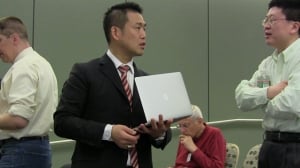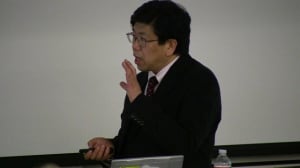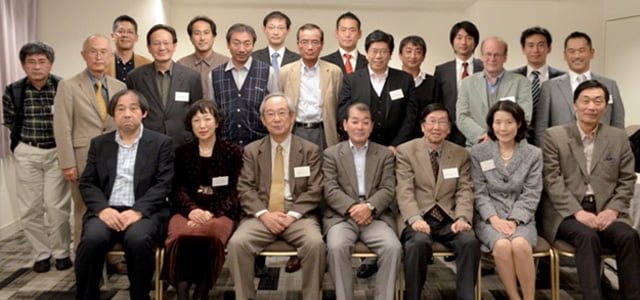Title photo: Japanese Cold Fusion Society Meeting 15 participants.
A new research venture has launched between Tohoku University and Clean Planet Inc. in Japan.
Leading the research team is Dr. Yasuhiro Iwawura, who has left Mitsubishi Heavy Industries, along with Dr. Takehiko Itoh, after years of work demonstrating nuclear transmutations in cold fusion environments, in one case turning Cesium into Praseodymium.
From a March 30 press release:
Clean Planet Inc. and The Research Center for Electron Photon Science of Tohoku University agreed to establish the collaborative research division – Condensed
Matter Nuclear Reaction Division at Tohoku University.In this division, fundamental research on condensed matter nuclear reaction, R&D on energy generation and nuclear waste decontamination will be performed.
The members of the new division consist of researchers of Tohoku University, Clean Planet Inc. and HEAD (Hydrogen Engineering Application & Development Company).
Yasuhiro Iwamura and Takehiko Itoh left the research center of Mitsubishi Heavy Industries at the end of March 2015 to complete the formation of this illustrious team.
This new division is made up of the following members:
• Yasuhiro Iwamura, Jirohta Kasagi and Hidetoshi Kikunaga (Condensed Matter Nuclear Reaction Division, Research Center for Electron Photon Science, Tohoku University, Japan)
• Tadahiko Mizuno (HEAD, Japan)
• Hideki Yoshino, Takehiko Itoh and Masanao Hattori (Clean Planet Inc., Japan)

Listen to Replicable Model for Controlled Nuclear Reaction using Metal Nanoparticles [first few minutes of audio missing] [.pdf] [.mp3] [video]
In an article Commercial Developments presented at 2014 MIT Cold Fusion Conference, author Robert Paulson wrote of Clean Planet:
At the conference, Clean Planet showed off their proof of concept reactor which operates at a COP of 1.9 as well as some other reactors being built which are made to operate at the 1kw and 10kw power level. Their reactor is simple and an amazing spectacle to watch. Using normal nickel mesh, they create a brilliant plasma to sputter the surface of the metal, cleaning it and creating surface nanostructures which kick off the Cold Fusion effect. Preparing their material inside of the reactor may solve some of the material consistency issues other commercial groups are struggling with.
They have a well equipped lab with gamma and neutron radiation detection, although they have not seen any consistent hard radiation outside their reactor during excess heat, they have some some occasional bursts.
Clean Planet also presented mass spectroscopy results which confused many scientists and has started a wave of speculation regarding theory. In the mass spectroscopy results, higher masses decreased during excess heat at the expense of lower masses, opposite to what would be expected of fusion events. Clean Planet was quick to point out that these results should be seen as preliminary, their equipment can not separate deuterium and helium so until their outside gas analysis comes back they don’t have solid information.
Japan is in dire need of this technology and has historically been supportive of cold fusion research, we can expect Japan to have a serious presence in the Cold Fusion commercialization race. While Mizuno skyped in, his group was represented at the conference by multiple businessmen, they look to have all the resources they need and attracting funding and talent should not be an issue. This is a company to keep an eye on, they could quickly develop a foothold at the head of this field.
MIT Conference video: http://www.youtube.com/watch?v=DB_MRUX4mo0
Public-private partnerships have long been a feature of Japanese LENR research, with many academic experimentalists and theoreticians working with industry to both research LENR science and develop applications. Located in Sendai, Miyagi in the Tohoku Region, Japan, Tohoku University is the third oldest Imperial University in Japan.
 Yasuhiro Iwawura, together with Mitsuru Sakano, Shizuma Kuribayashi, and Takehiko Itoh, had announced plans to work with Tohoku University ten years ago in a paper Observation of Nuclear Transmutation Induced by Deuterium Permeation through Pd Complex published by Mitsubishi Heavy Industries, Ltd. Technical Review. Co-author Itoh will join Iwamura on this new project associated with Clean Planet, Inc.
Yasuhiro Iwawura, together with Mitsuru Sakano, Shizuma Kuribayashi, and Takehiko Itoh, had announced plans to work with Tohoku University ten years ago in a paper Observation of Nuclear Transmutation Induced by Deuterium Permeation through Pd Complex published by Mitsubishi Heavy Industries, Ltd. Technical Review. Co-author Itoh will join Iwamura on this new project associated with Clean Planet, Inc.
The Japanese government will provide funding for the nuclear waste decontamination research project named “Reduction and Resource Recycle of High Level Radioactive Wastes with Nuclear Transformation” through the ImPACT Program, a Japanese national research program.
Watch Yasuhiro Iwamura present “Recent Advances in Deuterium Permeation Induced Transmutation Experiments Using Nano-Structured Pd/CaO/Pd Multilayer Thin Film” at ICCF-18:
Listen to Yasuhiro Iwamura present an updated version of Deuterium Permeation Induced Transmutation Expt. using Nanostructured Pd/CaO/Pd Multilayer Thin Film at the 2014 CF/LANR Colloquium at MIT. [.pdf] [.mp3] [video]
Mitsubishi was also featured in Paulson’s review:
Mitsubishi Heavy Industries research program, headed by Dr. Yasuhiro Iwamura had some big developments since their last presentation 8 months ago at ICCF18. They are focusing on technology which maximizes transmutation using a gas permeation process, previously reporting that they were able to use the cold fusion effect to transmute cesium to praseodymium, essentially producing a valuable material from a radioactive waste.
While transmutation in this field has been a proven reality, a well funded drive to engineer this effect could lead to enormous advances in many fields of technology. Transmutation could solve both issues with nuclear contamination as well as material scarcity, including exotic isotopes.
A research program at NRL failed to replicate these results. At ICCF18 Dr. David Kidwell spoke the same day as Dr. Iwamura about NRL’s failure to replicate the results, he was overly aggressive and had a very mocking tone, accusing them of improper use of equipment, sloppy work and accidentally spiking samples after apparently finding praseodymium contamination in their lab. While the motives behind the NRL bullying were foggy, they ate crow pie a few months later when Toyoto affiliated labs published results showing that they had replicated the transmutation effects in this experiment.
MHI originally said they used gas permeation through a palladium film ion-implanted with cesium to trigger the effect and transmute the cesium to praseodymium. At MIT, Dr. Iwamura showed new developments in their transmutation research; they started developing modular experiments so they can scale up the device to commercial levels.
Dr. Iwamura revealed that they had began hybrid electrochemical experiments where they are using cesium in a liquid solution. This may not only be more effective due to the known electrochemical methods of triggering the effect, but it will also have engineering benefits such as cooling and scalability.
This is an enormous breakthrough if it can transmute Cesium in a liquid solution at high yields. Considering water contaminated with cesium is the main contamination at Fukushima, this technology could not only clean up the radiation but also generate heat as a side product. The potential here is enormous, not only for Japan, but for the world, and Mitsubishi Heavy Industries is quickly moving forward.
MIT Conference video: http://www.youtube.com/watch?v=OzZl9l8nn1c
The mission of the new Center is to develop a clean, safe and abundant form of energy for our global community. The transmutation effect of the cold fusion environment offers a chance to clean up the mistakes of the past, as well as begin again with an ultra-green source of power.
Clean Planet also says “We are determined to bring the application models from this division to the market before the Tokyo Olympics in 2020,” and with the team of researchers on board, they just might win that race.
Related Links
JCF-15 pairs Experiment and Theory
Industry and academic partnerships report from JCF-14 meeting
Japanese Cold Fusion Research Society meeting papers released

